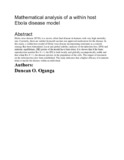| dc.contributor.author | Oganga, Duncan | |
| dc.date.accessioned | 2021-12-31T09:27:17Z | |
| dc.date.available | 2021-12-31T09:27:17Z | |
| dc.date.issued | 2020-01 | |
| dc.identifier.uri | https://doi.org/10.12988/ams.2020.914218 | |
| dc.identifier.uri | http://www.m-hikari.com/ams/ams-2020/ams-9-12-2020/914218.html | |
| dc.identifier.uri | http://ir-library.mmust.ac.ke:8080/xmlui/handle/123456789/1987 | |
| dc.description.abstract | Ebola virus disease (EVD), is a savere, often fatal disease in humans
with very high mortality rate. Currently, there are neither licenced
vaccines nor approved medication for the disease. In this study, a within
host model of Ebola virus disease incorporating treatment as a control
strategy has been formulated. Local and global stability analyses of
the infection free, (IFE) and endemic equilibrium, (EE) points of the
model have been done. It is shown that if the basic reproduction number
Rw
0 < 1, the IFE is both locally and globally assymptotically stable and
that when Rw
0 > 1, the disease persists in the population of the cells.
The impact of treatment on the infection has also been established. The
study indicates that a higher efficacy of treatment helps to tackle the
disease within an individual. | en_US |
| dc.language.iso | en | en_US |
| dc.publisher | Applied Mathematical Sciences | en_US |
| dc.subject | Mathematica, analysis, a, within, host, Ebola, disease, model | en_US |
| dc.title | Mathematical analysis of a within host Ebola disease model | en_US |
| dc.type | Article | en_US |

